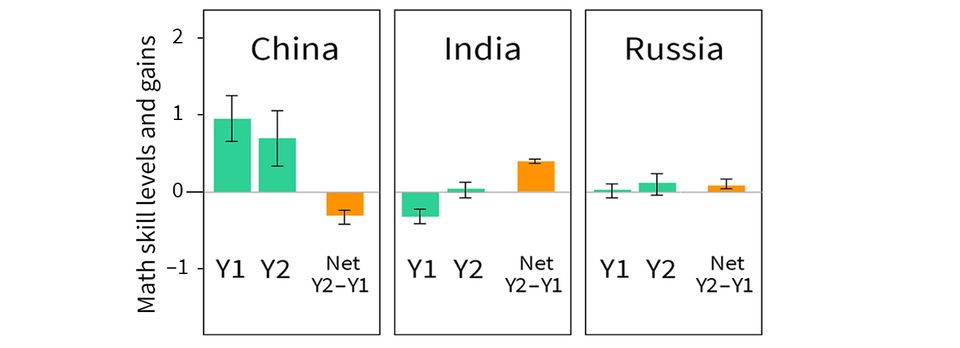University Education in China: Meeting the 21st Century Challenge?
University Education in China: Meeting the 21st Century Challenge? [ 4 min read ]
Insights
- China’s students scored similarly to U.S. freshmen at the beginning of college in measures of critical thinking.
- China’s students exhibit either no increases or marked declines in critical thinking and STEM abilities over the course of their undergraduate years.
- Declining skill levels overall call into question whether China’s universities are equipping their students with higher-level skills critical for national competitiveness.
Source Publication: Prashant Loyalka et al. (2021). Skill Levels and Gains in University STEM Education in China, India, Russia and the United States. Nature Human Behaviour.
Universities contribute to economic growth and national competitiveness by equipping students with critical thinking and academic skills. In order to build a more innovative economy, China has invested heavily in university science, technology, engineering, and mathematics (STEM) education. But little is known about how the critical thinking and STEM skills of China’s university students compare to those of peers in other countries.
The data. Researchers collected internationally standardized assessment data on critical thinking and STEM skills from nationally representative samples of tens of thousands of computer science and electrical engineering undergraduates in China, India, and Russia, which produce about half the STEM graduates in the world. By using large-scale, representative samples from each country, this study is the first of its kind. Researchers also expanded the dataset by including information on critical thinking skills of U.S. STEM students collected by Educational Testing Service (ETS).
The study measured two areas of skills acquisition: (1) STEM learning based on student performance in mathematics and physics tests; and (2) critical thinking skills based on tools developed by ETS that measure students’ ability to develop valid arguments, evaluate evidence, understand implications and consequences, and differentiate between causation and explanation.
First-year China and U.S. students have higher critical thinking skills. Freshmen students in China exhibit comparable levels of critical thinking skills to peers in the U.S., and both score higher on these measures than freshmen in India and Russia.
Levels and gains over four years of college with benchmarks from the U.S. (in standard deviation units)

Declining critical thinking skills in the latter half of college in China. Students in China, India, and Russia show virtually no improvements in their critical thinking skills after two years of college. They then exhibit declines during their final two years. By contrast, students in the U.S. make significant strides in critical thinking during their junior and senior years. Thus, despite similar scores at the outset, students in China score much lower by their senior year than their fourth-year counterparts in the U.S.
Levels and gains after two years of college across three countries (in standard deviation units)

Narrowing advantage in mathematics and physics for students in China. Freshmen in China display significantly more advanced STEM skills in mathematics and physics compared to freshmen in both India and Russia. Yet, China’s advantage in math and physics skills narrows substantially after two years. While students in India and Russia experience positive and significant gains, especially in math, students in China make negligible to negative progress (i.e., they lose skills). By the end of sophomore year, student advantage in STEM skills in China narrows considerably.
Are China’s investments in higher education paying off? This analysis sheds light on the capacity of four major economies to produce skilled graduates in STEM fields, which may have important implications for their economic development and competitiveness. When undergraduates in China begin their college careers, they consistently outperform students in India and Russia in both critical thinking skills and STEM skills. Yet, the critical thinking and STEM skills of China’s undergraduates decline over the four years of their college education.
These findings raise questions about the quality of China’s higher STEM education system. Specifically, is China’s increasing public investment in universities effective at equipping students with skills critical for its push to build an innovative economy and escape the middle income trap?
